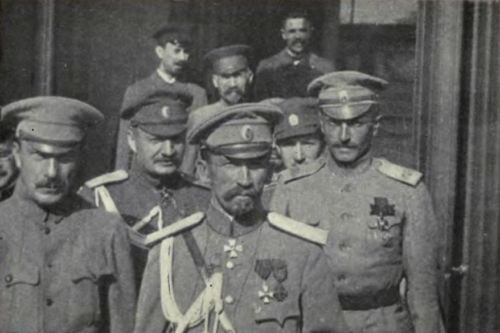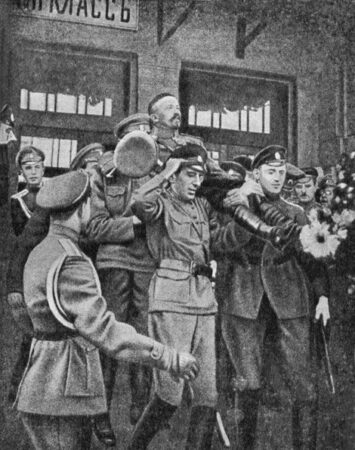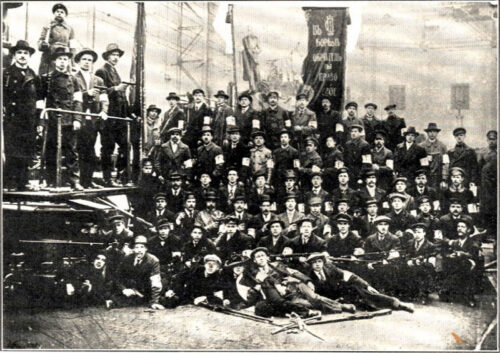
The Kornilov affair was a confused episode in August 1917, where for a time the Provisional Government seemed to be under threat from its own army. For several days General Lavr Kornilov, a career officer loyal to tsarism, attempted to gather both troops and financial support so he could occupy Petrograd and restore order there. Kornilov claimed to be acting on Kerensky’s instructions; Kerensky painted Kornilov as a counter-revolutionary who wanted to install himself as a military dictator. Almost a century later, no evidence has emerged to vindicate either man. What is certainly known is that the Kornilov fiasco exposed fractures in the Provisional Government, while highlighting the weakness of its position. The Provisional Government was incapable of withstanding any concerted threat to remove it.
In summary, Kornilov was a figure of the old order rather than the new one. Yet he was probably the best general in the Russian army, which made him indispensable to the government. In July, following the disastrous offensive in Galicia and the sacking of General Brusilov, Kerensky appointed Kornilov as commander-in-chief of the army.

Kornilov was a traditionalist who believed both capital and corporal punishment were essential for enforcing order and discipline. Anyone who criticised those methods or prevented their employment, Kornilov held in contempt. Animosity between Kornilov and the Provisional Government dated back to April when he was commander of the Petrograd garrison. When disruptive anti-war protests erupted on April 21st, Kornilov sought permission to send Cossacks into the streets, whips cracking and guns blazing. But the government, under pressure from the Petrograd Soviet, refused this request. Kornilov resigned as garrison commander and returned to the battlefield. Once there, he badgered the government with telegrams requesting the reversal of its March order banning capital punishment in the army. Without the threat of a firing squad, Kornilov argued, it was almost impossible to control desertion and fraternisation. Kerensky finally relented on July 12th, granting Kornilov the authority to order summary executions.
What happened between Kornilov and Kerensky in August has led to several interpretations, none of them wholly supported by evidence. Both men attended and addressed a state conference, held in Moscow on August 12th. After the conference, Kornilov was involved in behind-the-scenes discussions about how government authority might be strengthened and radical socialism must be crushed. The general met several wealthy Russians onboard a train, where he sought their moral and financial backing for the military occupation of Petrograd. Claiming to have Kerensky’s approval, Kornilov said it was his intention to march troops into the capital, arrest the Bolsheviks, disperse the Soviet and restore order. He also promised his loyalty to the future Constituent Assembly. “As long as the Bolsheviks are sitting in the Smolny, nothing can be done,” Kornilov told them. It is likely that Kornilov also met with other groups, including his fellow military officers, to drum up support for his move against Petrograd.

It is unlikely that Kerensky gave Kornilov explicit instructions to march troops into Petrograd. While Kerensky might have liked to rid himself of the Petrograd Soviet and Bolshevik agitators, he was probably no more trusting of Kornilov, who had previously mooted the suggestion of imposing martial law. Accepting Kornilov’s army into the city brought with it the risk of a military counter-revolution. When Kerensky heard rumours about Kornilov’s plans, he immediately contacted his general by telegram to seek confirmation of his intentions. Kornilov responded but his answer did not satisfy Kerensky, who by now was convinced that a military coup was imminent. He immediately sacked Kornilov and called on the Petrograd Soviet to protect the government, should Kornilov proceed to move against the city. The Soviet was able to short-circuit any chance of an attack by informing delegates and organisers in military units under Kornilov’s command. Meanwhile, in Petrograd, Soviet troops – many of them Bolshevik Red Guards – were given arms and ammunition to guard the city limits from a possible assault. At the insistence of the Soviet, several Bolshevik organisers, including Trotsky, were released from prison.
“The fact that Kornilov refused to submit to the Provisional Government means that the Kornilov affair must be considered a case of military intervention. There is no doubt that Kornilov was insubordinate and took steps to change the executive leadership of the state. This, however, is not proof of a previous plot to overthrow the government; the evidence for a Kornilov conspiracy is weak. Everyone at Stavka believed that Kornilov and Kerensky were working together. The only witness who claimed to have direct evidence for the existence of a plot was L’vov, and his testimony was contradicted by three other witnesses.”
Brian D. Taylor, historian
In September 1917, Kerensky and his ministers tried to consolidate their position by declaring Russia to be a republic and appointing a five-man ‘directory’ to run the country. But they also made a public commitment to the war, a decision that triggered a general strike on Russia’s railways which paralysed the country for three days. By mid-September, the German army had captured Riga in the Baltic and had advanced closer to Petrograd that at any stage of the war. The Bolsheviks renewed their anti-war propaganda campaign and began to attract much greater levels of support. At the beginning of 1917 the Bolsheviks had just 24,000 card-carrying members; by the end of September this had blown out to more than 400,000 members. This growth in support was reflected in the Soviets, where Bolsheviks now held voting majorities in both Petrograd and Moscow. The Red Guards, the Bolshevik militia, also boasted around 100,000 men, mostly factory workers and current or former soldiers. A few weeks before, troops loyal to the Provisional Government had scattered Bolshevik agitators during the ‘July Days’ uprising. But by late September the tables had turned – and the path was cleared for yet another Russian revolution.

1. General Kornilov was a conservative tsarist officer who was appointed to command the army in July 1917.
2. Disgusted by the influence of socialists and the unrest in Petrograd, he sought to impose martial law there.
3. Kornilov was sacked by Kerensky, who called on the Soviets and Red Guards to help protect the capital.
4. The Kornilov affair further isolated the Provisional Government, while allowing for a revival of Bolshevik fortunes.
5. By September 1917 the Bolsheviks had exploited the government’s misfortunes to increase its membership and gain significant majorities in the Petrograd and Moscow Soviets.
© Alpha History 2018. Content on this page may not be republished or distributed without permission. For more information please refer to our Terms of Use.
This page was written by Jennifer Llewellyn, John Rae and Steve Thompson. To reference this page, use the following citation:
J. Llewellyn et al, “The Kornilov affair” at Alpha History, https://alphahistory.com/russianrevolution/kornilov-affair/, 2018, accessed [date of last access].
